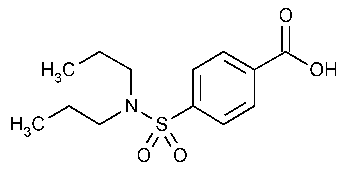Probenecid
Benzoic acid,4-[(dipropylamino)sulfonyl]-.
p-(Dipropylsulfamoyl)benzoic acid [57-66-9].
»Probenecid contains not less than 98.0percent and not more than 101.0percent of C13H19NO4S,calculated on the dried basis.
Packaging and storage—
Preserve in well-closed containers.
Identification—
A:
Infrared Absorption á197Kñ.
B:
Ultraviolet Absorption á197Uñ—
Solution:
20µg per mL.
Medium:
alcohol.
Absorptivities at 248nm,calculated on the dried basis,do not differ by more than 3.0%.
Acidity—
To 2.0g add 100mLof water,heat on a steam bath for 30minutes,cool,filter,and dilute with water to 100.0mL.To 25.0mLof this solution add 1drop of phenolphthalein TS,and titrate with 0.10Nsodium hydroxide:not more than 0.50mLis required to produce a pink color.
Loss on drying á731ñ—
Dry it at 105 for 4hours:it loses not more than 0.5%of its weight.
for 4hours:it loses not more than 0.5%of its weight.
Residue on ignition á281ñ:
not more than 0.1%.
Selenium á291ñ:
not more than 0.003%,a 100-mg test specimen,mixed with 100mg of magnesium oxide,being used.
Heavy metals,Method IIá231ñ:
not more than 0.002%.
Chromatographic purity—
Test preparation—
Use the Assay preparation.
Procedure—
Inject about 20µLof the Test preparationinto the chromatograph,record the chromatograms,and measure the responses for all of the peaks.Calculate the percentages of each peak,other than the solvent peak and the probenecid peak,in the portion of Probenecid taken by the formula:
100(rI/rT),
in which rIis the response of each peak and rTis the sum of the responses of all of the peaks,excluding that of the solvent peak:not more than 0.5%of any individual impurity and not more than 2.0%of total impurities is found.
Organic volatile impurities,Method Vá467ñ:
meets the requirements.
Solvent—
Use dimethyl sulfoxide.
Assay—
Sodium phosphate solution—
Prepare in glacial acetic acid solution (1in 100)a 0.05Msolution of monobasic sodium phosphate,and adjust with phosphoric acid to a pHof 3.0.
Mobile phase—
Prepare a degassed and filtered mixture (50:50)of Sodium phosphate solutionand a 1in 100solution of glacial acetic acid in acetonitrile.Make adjustments if necessary (see System Suitabilityunder Chromatography á621ñ).
Standard preparation—
Dissolve an accurately weighed quantity of USP Probenecid RSin Mobile phaseto obtain a solution having a known concentration of about 0.50mg per mL.
Assay preparation—
Transfer about 50mg of Probenecid,accurately weighed,to a 100-mLvolumetric flask,dissolve in and dilute with Mobile phaseto volume,and mix.
Chromatographic system
(see Chromatography á621ñ)—The liquid chromatograph is equipped with a 254-nm detector and a 3.9-mm ×30-cm column that contains packing L11.The flow rate is about 1mLper minute.Chromatograph the Standard preparation,and record the peak responses as directed for Procedure:the tailing factor is not more than 2.3,the number of theoretical plates is not less than 3900,and the relative standard deviation for replicate injections is not more than 1.5%.
Procedure—
Separately inject equal volumes (about 20µL)of the Standard preparationand the Assay preparationinto the chromatograph,record the chromatograms,and measure the responses for the major peaks.Calculate the quantity,in mg,of C13H19NO4Sin the portion of Probenecid taken by the formula:
100C(rU/rS),
in which Cis the concentration,in mg per mL,of USP Probenecid RSin the Standard preparation,and rUand rSare the peak responses obtained from the Assay preparationand the Standard preparation,respectively.
Auxiliary Information—
Staff Liaison:Elena Gonikberg,Ph.D.,Scientist
Expert Committee:(PA4)Pharmaceutical Analysis 4
USP28–NF23Page 1621
Phone Number:1-301-816-8251
